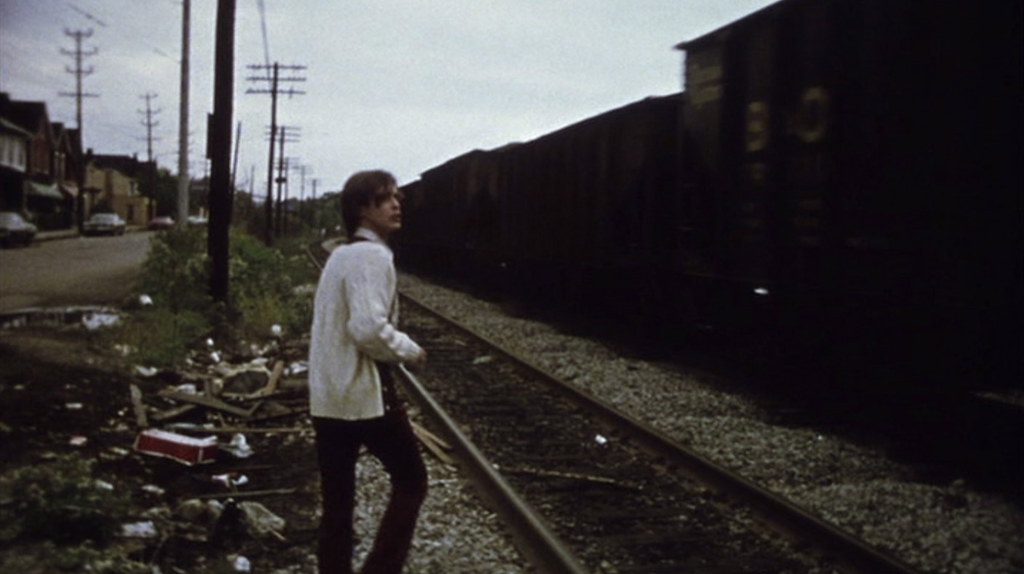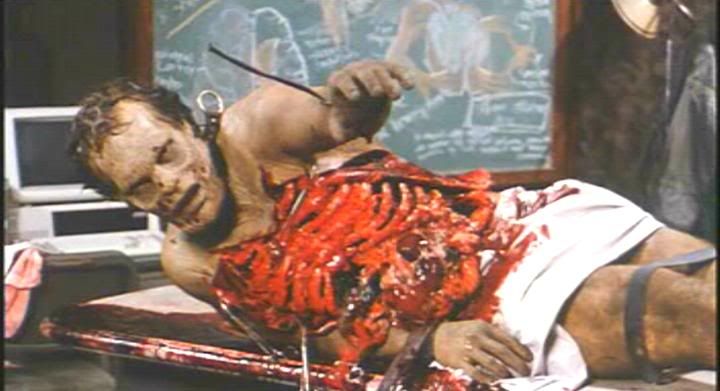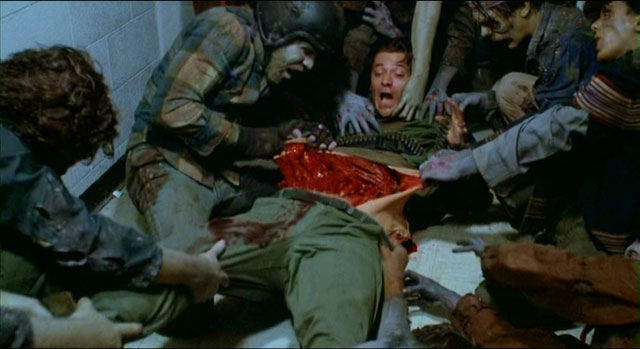Well it's been mostly bad news since the start of Romero Appreciation Month, but I have the first bit of really excellent news. I don't think in all my years of going to movie theatres to see new movies had I ever been so absolutely thrilled with a film as when I went to see the remake of
Dawn of the Dead. I had been anticipating the film for close to a year before its release and at no time during the film did I feel the least bit disappointed. This was, other than
The Thing, the best remake I'd ever seen, and is one of the best zombie movies of all time.
Dawn of the Dead
by Zach Snyder

See that Strike production label? That's hint number one that this film rocks. A nurse named Ana listens to an arrogant doctor plan his weekend while she waits to tell him about a peculiarity with one of the patients she's been treating. The doctor doesn't know what to make of the irregularity (unusual complications resulting from a bite), and dismisses her. She chats with another nurse, drives home, chats with a neighborhood girl, and sleeps with her husband. This about as convincing a portrayal of normality a horror movie has ever been capable of. Of course, it is this normality that makes us in the audience chomp at the fucking bit waiting for the zombies. Luckily it's not even ten minutes into the film when the action starts. The next morning the little girl from the neighborhood walks into their bedroom with a huge bite on her face. Ana's husband sees to her wounds and gets bitten on the neck for her troubles. Ana tries to stop the bleeding and call an ambulance but the line is busy. In about three seconds time her husband stands up and leaps at her, his eyes black and lifeless. She grabs her car keys and climbs out the bathroom window, her husband in pursuit. Outside it seems the entire neighborhood has fallen victim to more of the same thing. Men and women chase after each other in the streets, a man with a gun takes potshots at them before being hit by a car, and just before leaving, Ana's husband leaps on top of her car and smashes her windshield with his fist. On the expressway a man tries to pull Ana out of her car when she stops to watch two people attack and kill someone in the back of a bus, causing her to crash her car. When she wakes up she meets a burly policeman named Kenneth, a hood named Andre and his pregnant Russian girlfriend Luda, and an average looking guy named Michael. They all head to the mall, believing it to be safer than the streets.

The mall will provide some safety, but not unconditionally. They meet two zombies upon first investigation; Michael sticks a broken croquet mallet through the first one's skull and Kenneth and Ana manage to incapacitate the second. When they flee to the second floor they find that they're not alone; three security guards (militaristic C.J., ignorant Bart, and sensitive Terry) who were working the night shift when the zombies took over. C.J. wants them to go right the hell back where they came from, instinctively distrusting everyone he can't overpower (Kenneth is massive and were it not for his injured arm may just have kicked all three of these men's asses right then and there). Ana, seeing no alternative surrenders the only guns they carry and agrees to take orders from these dipshits. C.J. quarantines everyone in an electronics store to watch coverage of the military's handling of the zombie situation; Michael, suspecting that unless someone says something, they're going to be doing a lot of sitting on their asses, suggests they signal for help on the roof and take care of the unfinished zombie on the first floor. They agree to help, and while Ana and the others paint 'HELP' in big letters on the roof, Andre and Luda go to the bathroom to look at the bite on Luda's arm. They stupidly but understandably keep it a secret and agree to sequester themselves away from the rest at the earliest convenience. This will prove difficult if things continue the way they are; C.J. and Bart lock everyone in the department store before going to sleep in the electronics store.
The next morning is when things get moving; the TV signals have all gone dead, which means for all our heroes know they're the last people on earth. Ana convinces Terry to let everyone out to use the bathroom and change clothes and while he observes the security cameras he notices a Mack truck tear assing through the parking lot. C.J., who's already displeased with the interlopers he's got, wants nothing to do with this new batch. Kenneth, Michael, Ana, and Terry manage to overpower him and put him and Bart in mall prison. When they manage to get the truck and all of it's passengers indoors, tragedy proves enlightening. The new recruits are Tucker, a tall guy who looks a little like Randy Quaid; Steve, an asshole yuppie; Norma, the old woman who drove the truck; an older guy named Glen who looks like he just finished his shift at the diner; Monica, a blonde who will add nothing to the plot save for seconds of teenage boy appeal; Frank, an older man with his twenty-something daughter, Nicole, and a morbidly obese women in a wheelbarrow. Kenneth, despite the fact that now there are people to interact with wants to leave in search of his brother who is supposedly at a nearby fort. He'd leave were it not for the report that some of the new people give about the fort being overrun and abandoned. He agrees after the morbidly obese woman with bite marks withers and dies, only to rise up and chase Ana around a furniture store. Ana drives a tending iron through her eye and she is subdued. So if the evidence is to believed, a bite kills you and brings you back seconds later to kill and repeat, bad news for Frank. He'd been bitten and Ana can barely talk Michael and Kenneth down from their urge to kill him and preserve the others; the best she can get is that they'll let him die before shooting him to spare his daughter the pain of having her dad murdered.
Then, with all in-house problems wrapped up nicely, we have the "what the mall has to offer" scene. They hit golf balls off the roof, watch movies on the obscenely large TVs, film themselves having sex, and spy celebrity-look-alike zombies for the guy on the roof of the gun store across the way to shoot at. They would probably have lived like this for a lot longer were it not for two things: the sudden loss of power and Luda's pregnancy. Andre did a pretty good job keeping Luda away from the others as she has both gotten more pregnant and begun to show signs of decomposition. Andre fixes her in restraints because as he predicts she dies giving birth and comes back before the child is born. Undeterred, Andre finishes without the help of his partner. When Norma walks in and witnesses the macabre delivery room she pulls her gun to kill the new mother, and she and Andre shoot one another. Meanwhile, Michael and Kenneth take Bart and C.J. to the parking garage below ground to restart the generator. In a scene clearly inspired by the tire changing from
28 Days Later, zombies find them, eat Bart, and block the other men in the fenced-in area surrounding the generator. They manage to ward off their attackers using gasoline and a cigarette lighter, but this is the final straw for Kenneth who proposes they leave, but fast. They all agree on a hastily slapped together plan to fortify the mall shuttles with aluminum siding, chainsaw slits, and big cans of propane so they can head to the gun shop, pick up it's owner and a bunch of guns, then head for Steve's boat which sits at the harbour on the other side of town. Seems fool proof, until some nonsense with Nicole's dog throws a monkey wrench in the works that puts their plan into effect ahead of schedule.

That director Zach Snyder had only done commercials and writer James Gunn graduated from Troma's stable of anti-talent before making this movie speaks volumes about their love for the original. The movie is also paced like a pulp novel; there isn't a dull moment. I haven't since this film been so riveted in a theatre. Snyder balances horror, action, and levity better than any other young director in recent memory, and were it not for the epilogue I'd say it was one of the few new horror films with a happy ending. Gunn's screenplay can't escape some of his B-horror roots, but he stays far away from the bigger mistakes film makers his age make (He'd make a few more of 'em later in his Slither the next year). Snyder does a terrific job making us care about the people in the mall and does something no other director has attempted in 20 years, having the villain turn into a hero. C.J. starts as a prick who loves the tiny bit of power he wields, but seeing his only real friend killed humbles him enough to see the common good. He would like to be in charge, but would like to survive even more. His change makes perfect sense and makes for an interesting conclusion; if they had to combat both him and the zombies, it may have been just a little much (want to know what happens when you combine too many conflicting villainous forces watch
Resident Evil). Snyder and Gunn try hard (and mostly succeed) to make you forget the reason that they're making this movie is because of Danny Boyle's
28 Days Later. It isn't as gritty or hard-hitting as Boyle's film, but it's still immensely entertaining and of higher quality than most of your big screen horror films. The zombies, the editing, cinematography, secondary love stories, and gunplay-laden conclusion are all inspired by
28 Days, but
Dawn is bigger and meaner than
28 Days (I have explosions and chainsaws to prove it). I think Gunn's opening has ten times the impact of
28 Days. Instead of warning us what's going to happen, it just happens. Brilliant.
As a remake it delivers (though the plot is a bit backwards what with trucks and boats coming last in the new one). Gone is most of the labouring over the consumer America theme and the mall as a character. The mall itself is much less unique a setting in 2004 than it was 1978, so all of it's wonders and facets are only given one minute-and-a-half-long segment. Present is the mixture of action and violence (I give props to this films ability to actually scare. The original
Dawn was creepy, but never really got around to doing any first-rate scaring. The new dawn is profoundly frightening when it chooses to be), most notably in the scenes in the sewer, and the drama inherent in watching your loved ones become zombies (also present: three original cast members). Gunn is interested in exploring the effects of human relationships during the crisis, like Romero did with Stephen and Fran in the first film (and secondarily with Peter and Roger, and the Puerto Rican couple in the tenement building). The movie starts with one such kick in the stomach; Ana first sees a neighborhood kid turn and then her husband and quickly sees that everything and everyone in her life is gone, irreversibly changed. She doesn't understand it, and so her taking the time to figure out how the whole thing fits logically (Gunn's dialogue comes close to sounding like nerd-linger speak here, but luckily all the principles are decent actors. Sarah Polly, Ving Rhames, Michael Kelly, Mekhi Phifer and Jake Webber are all strong and capable leads, and Snyder isn't quite so flat a director as Gunn is a writer, but neither man does too shabby a job). The next jolts comes when Andre watches his wife and unborn child slowly drift away from him. Nicole has to say a very hurried goodbye to the only family member she has left. C.J. experiences is to a lesser degree when Bart is killed, though this serves more to demonstrate that his tiny world-view needs some expanding. He would have died without Kenneth and Michael, who go out of their way to help him. Little things like this make Gunn a little more 3 dimensional a screenwriter than Romero who keeps his characters on the same downward spiral from start to end. Everyone in Snyder's
Dawn is conflicted and almost all of them have a big weight on them, a loss of some kind. Gunn doesn't just give people reasons to live, he gives them reasons to die too, and how each one gets over it is the focus of the second act. The third act is a little closer to Romero territory, everyone on the same page, all of them focused on escape and preserving each other's and their own lives. It's a good feeling after the likes of Steve Miner's
Day of the Dead to see a film where the characters care enough about to each other to help each other survive and I, as an audience member root for all of them. Another key difference is in the pacing. Snyder, working with a younger, ADD addled audience makes his film move in ways Romero's never does. The difference in temporal feeling can be likened to the differences in the two films' zombies. Romero's plot, like his zombies, shambles from victim to victim; Snyder's film tears ass and leaves a whole lot of blood in its wake.





































